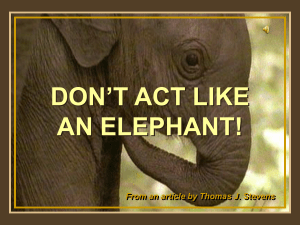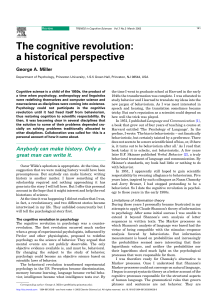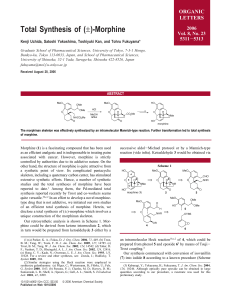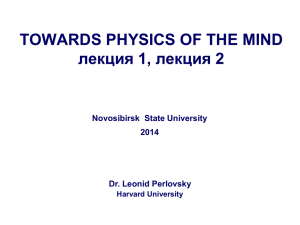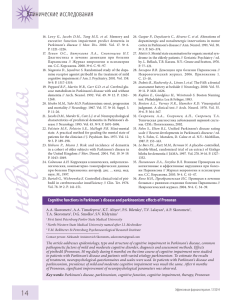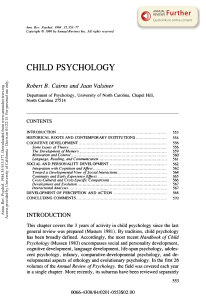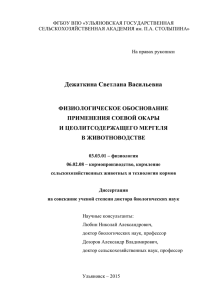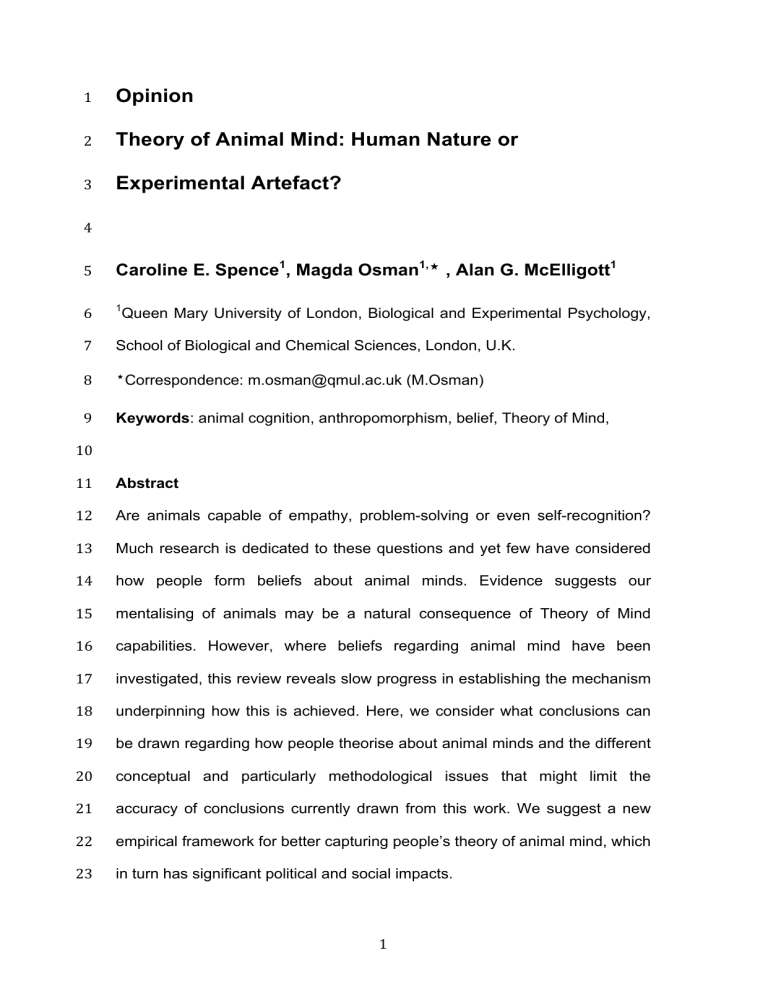
1 Opinion 2 Theory of Animal Mind: Human Nature or 3 Experimental Artefact? 4 5 Caroline E. Spence1, Magda Osman1,★ , Alan G. McElligott1 6 1 7 School of Biological and Chemical Sciences, London, U.K. 8 ★ 9 Keywords: animal cognition, anthropomorphism, belief, Theory of Mind, Queen Mary University of London, Biological and Experimental Psychology, Correspondence: [email protected] (M.Osman) 10 11 Abstract 12 Are animals capable of empathy, problem-solving or even self-recognition? 13 Much research is dedicated to these questions and yet few have considered 14 how people form beliefs about animal minds. Evidence suggests our 15 mentalising of animals may be a natural consequence of Theory of Mind 16 capabilities. However, where beliefs regarding animal mind have been 17 investigated, this review reveals slow progress in establishing the mechanism 18 underpinning how this is achieved. Here, we consider what conclusions can 19 be drawn regarding how people theorise about animal minds and the different 20 conceptual and particularly methodological issues that might limit the 21 accuracy of conclusions currently drawn from this work. We suggest a new 22 empirical framework for better capturing people’s theory of animal mind, which 23 in turn has significant political and social impacts. 1 24 25 “The difference in mind between man and the higher animals, 26 great as it is, is certainly one of degree and not of kind.” [1] 27 28 Thoughts on Animal Thinking 29 30 Scientific debate regarding the existence and nature of mental states in 31 animals has a longstanding history [2,3] and covers an extensive range of 32 topics from mirror recognition to numerosity (Box 1). Yet the majority of 33 people form beliefs about animal minds based on everyday occurrences, such 34 as when caring for pets [4] or consuming animal products. Understanding how 35 people construct this “Theory of Animal Mind” (TAM) is therefore likely to 36 reveal important insights, based on their experience and influence in relation 37 to animals. Additionally, as a form of internal construal of other minds, 38 examination of the psychological mechanisms generating TAM will likely have 39 broad implications on account of behavior interpretation not being limited to 40 human-animal relationships [5]. However, little research has been dedicated 41 to exploring the basis on which mental abilities are attributed to nonhuman 42 animals, despite few doubting the existence of animal mind [6,7]. 43 Furthermore, when directly questioned, people often substantiate their beliefs 44 with explanations from personal experience or media sources [7]. As a result, 45 it is highly unlikely that the psychological mechanisms that contribute to TAM 46 are analogous to the reasoning used by scientific experts to support 47 judgements on animal cognition [8]. This mismatch gives rise to several 48 ethical, scientific and societal issues. Ethical issues arise because views on 2 49 the sentience of different species are correlated with attitudes towards their 50 use and treatment by humans [9,10]. Therefore, not only is TAM a potential 51 driver of positive human-animal interactions [11], but also welfare-related 52 decisions for millions of animals that are currently based upon psychological 53 mechanisms we know little about. Scientific issues emanate from empirical 54 approaches to animal cognition, which likely contaminate research design and 55 produce a biased or inaccurate snapshot of the overall picture of TAM. Social 56 issues are associated with decision-making in related policy areas such as 57 animal welfare, food security and climate change that are, understandably, 58 driven by current scientific opinion. The behavior change envisaged by policy 59 makers is unlikely to be realised if supporting evidence does not accurately 60 capture peoples actual thought processes [12,13]. 61 As such, this article is important and timely, and designed to expose 62 some of the core issues regarding the evidence available in relation to TAM 63 as well as the research methods commonly used to investigate the 64 phenomenon. Therefore, we start by identifying, and later proposing, a 65 candidate mechanism underlying the development of TAM that generates 66 judgements on the mindedness of non-human animals. Because TAM 67 involves animal ‘agents’, several theories of relevance from social psychology 68 are also discussed. Following on from this, we discuss ways in which 69 research methods might be affecting the results gained from previous TAM 70 research, and thus pose validity (see glossary) and reliability issues. We 71 propose a model that allows both conceptualisation and empirical 72 investigation of the initial stages of TAM using a measurement scale model 73 (specifically Churchill’s Scale Development Paradigm [14]), which in turn, 3 74 allows mechanisms contributing to TAM to be determined. We conclude by 75 discussing the importance of reframing TAM in terms of wider relevance to 76 ethical and policy issues than just animal welfare. 77 78 TAM as a Mechanism of Belief Formation 79 80 Often, people’s views on animal mind have been speculated to reflect a 81 simple accumulation of various disparate attitudes and beliefs that are often 82 informed by general society. In essence, we suggest that TAM is more 83 nuanced. It is based on a belief-generating cognitive mechanism that begins 84 by drawing on multiple sources of experience and knowledge that are 85 integrated in order to formulate a judgement (e.g., to what extent is this animal 86 intelligent?) or belief (e.g., I’m of the view that most animals are intelligent); 87 the belief/judgement is thresholded, requiring the establishment of criteria on 88 which to assign mindedness to some species over others. The mechanism 89 underpinning TAM consists of multiple components (Figure 1), similar to 90 general models of belief formation [15]. For example, relevant information is 91 encoded for later use in generating beliefs about TAM. Encoded information 92 may be descriptive, e.g. chimpanzees can use tools to harvest food, or 93 inferential, e.g. my dog wags his tail when we play ball, playing ball makes my 94 dog happy, ergo my dog experiences emotions. These different types of 95 information become integrated to produce stored schemas or constructs 96 regarding TAM. People may actively retrieve, or through associative memory 97 processes are prompted to draw, information from this store as a way of 98 establishing the certitude of their beliefs regarding TAM [16]. In other words, 4 99 cumulative perceived knowledge/experience from multiple sources allows an 100 individual to make an estimate that a specified animal possesses a particular 101 mental attribute that is indicative of TAM. If the estimate reaches a threshold 102 limit as determined by that individual, the concept of mind is bestowed upon 103 the animal. This process of belief formation is similar to many models 104 attributed to other domains [16,17]. Below we consider evidence that supports 105 speculation on several psychological theories in this mechanism and later, we 106 outline a framework that helps clarify conceptual and empirical issues when 107 investigating some of the key components of TAM. 108 109 TAM: Evidence of Influencing Psychological Theories 110 111 Because views on the existence of animal mind are influenced by the 112 idea of animals as social agents [7], we consider four theories, with origins in 113 social psychology, and their supporting evidence: Simulation Theory, 114 Cognitive Dissonance Theory, Terror Management Theory and Social 115 Dominance Theory. 116 117 Simulation Theory (ST) 118 119 In interacting with social ‘others’, we attempt to make sense of behavior 120 and predict future actions. Therefore, TAM, as the capacity to attribute mental 121 states to non-humans, is likely to be influenced by Theory of Mind capabilities. 122 This is supported by evidence suggesting that, similar to human-human 123 attributions [18], we confer greater mind to animals as we age [19][11]; most 5 124 likely because we generate more experiences on which to form the 125 beliefs/judgements, and to specify the details of the criteria on which they are 126 evaluated. The influence of ToM (specifically as Simulation Theory) is also 127 supported by people’s use of context and behavioral similarity between 128 animals and humans as a central factor in the psychological interpretations of 129 an animal’s actions [20]. Notably, people consider species an important 130 determinant of animal mind: 72% of survey participants believe chimpanzees 131 have human-like capacities to feel pain, while only 30% believe worms can 132 feel pain to a moderate degree [21]. Previously, this has been interpreted as a 133 cognitive ability being derived from phylogenetic similarity [20], with 134 evolutionarily more recent animals being seen as in possession of greater 135 mental abilities [9,22,23]. We suggest this finding is more likely due to the 136 influence of mental simulation within a TAM mechanism based on the 137 following evidence: 1) where differences in perceptions of species were found, 138 results varied in degree rather than kind [20], suggesting we are extrapolating 139 or ‘simulating’ from a human model, and 2) mirror neuron activation occurs 140 when people observe both human and non-human animals performing similar 141 actions [24]. 142 The idea that people view specific behaviors and then attribute mind 143 based on this is a common description of how we achieve TAM, and is also 144 supported by findings that when viewing animal behavior videos, participants 145 broke down scenarios into specific behavioral ‘event units’ [5]. Despite not 146 using every event unit to describe the behaviors seen, there was near perfect 147 agreement on the event unit nature/meaning and the total number present per 148 video. This evidence suggests that judgements were made based on 6 149 recognition of agent’s discrete actions rather than on their similarity to 150 humans. 151 152 A note on Simulation Theory as anthropomorphism 153 154 Skilled mind reading of a human target (in relation to ST) requires an 155 accurate replication of their mental states, but a simulator’s own mental states 156 may contaminate this process [25]. Because our interactions with animals 157 naturally preclude verbal confirmation of inaccurate mental states, it is unlikely 158 that over time, with more feedback from our interactions, we will develop 159 improvements in our mindreading. This, combined with the necessity of 160 simulating within a human mind, means attribution of anthropomorphic 161 mental abilities to animals is unavoidable (e.g. deception, self-recognition). 162 However, labelling these errors as anthropomorphic is unhelpful when 163 investigating TAM. In describing animal minds, people assign psychological 164 terms to specific shared behaviors, regardless of species [20] suggesting 165 ‘interpretative’ anthropomorphism rather than ‘imaginative’ [26]. Along with 166 accumulated knowledge and experience, this work shows that we look to 167 simulate the mind of animals, by assuming that similar actions to our own 168 reflect similar cognitions. 169 170 Cognitive Dissonance Theory (CD) 171 172 Empirical evidence suggests predominant societal attitudes to meat 173 eating underpin production animals being ascribed lower mental capacities; 7 174 an attempt to reduce the cognitive dissonance arising from this ethically 175 contentious yet widely adopted societal custom [27,28]. As such, these 176 mechanisms of dissonance reduction are likely to impact upon TAM and 177 manifest as opposing correlations between TAM and support for i) animal use 178 (negative) [19] and ii) animal welfare (positive) [10]. Because criteria upon 179 which this dissonance reduction is achieved may vary, we consider CD in 180 relation to TAM as two forms, terror management (TM) and social dominance 181 (SD). 182 In individuals with a preference for social hierarchies, dehumanisation 183 by ridding animals of mind and therefore moral worth [29], allows their 184 conception as an out-group and subsequent exploitation [6]. For example, 185 those who support animal experimentation endorse a greater mental divide 186 between humans and other species [9,30]. Conversely, experimental framing 187 of human-animal similarity has been shown to increase moral concern for 188 animals and human outgroups simultaneously [31]. This concept of out-group 189 dementalization can also be seen in our reduced attributions of mind to pest 190 species in comparison to other animals [32]. 191 In contrast to our social dominance orientation, which acts to reduce 192 animals perceived cognitive abilities, mechanisms of terror management aids 193 dissonance reduction by elevating humans in comparison to other animals. In 194 order to avoid the cognitive and emotional experiences inherent in awareness 195 of human or animal death (mortality salience), particularly as a result of 196 human activity (e.g., farming), we advocate the anthropocentric view that 197 humans rights be prioritised on the basis of sophisticated cognitive abilities 198 [6,31,33]. This elevation of own cognitive capacities can be seen in our 8 199 consistent segregation of humans at the top of mental ability scales [22,30] 200 (for a notable exception see [34]). 201 However, despite employing different criteria to create distinctions 202 between human and animal mentality, SD and TM show similarities in that 203 they likely depend upon the same belief formation processes. In contrast, 204 simulation theory, and anthropomorphism, are designed to develop criteria for 205 detecting similarities between humans and animals. 206 207 Theory of Animal Mind: Innate or Acquired? 208 209 Having set out what we propose as a candidate mechanism that 210 underpins TAM, as well as current theoretical proposals regarding TAM, we 211 now consider a key question that all theories need to address, namely that 212 TAM is innate or acquired. In other words, should a special status be 213 attributed to the formation of TAM? From the theories reviewed, the basic 214 mechanism of TAM is much like other processes/theories of belief formation. 215 However, the bank of perceived knowledge the mechanism employs is 216 subject to several influences that would likely predict individual differences in 217 the types of beliefs formed. For example, factors such as education [9], 218 exposure to media [7] and political orientation [35] are likely to cause variation 219 in TAM. Therefore, despite evidence of similarities across cultures when 220 ascribing mental states [36], individual and cultural context are likely to affect 221 the mechanism, as seen in Japanese students who ascribe greater 222 intelligence to crows compared to other nationalities [10]. However, while 223 observed variations may be considered the result of social traditions and 9 224 practices, the contribution of specific societal influences on TAM is 225 unsubstantiated as previous research has predominantly sampled WEIRD 226 (Western, educated, industrialised, rich and democratic) populations [37]. 227 228 Are there limitations to conclusions drawn from empirical research on 229 TAM? 230 231 To summarise, the effects of individual and social factors on the 232 mechanism of TAM is clearly interactive, fluid and warrant investigation. Yet 233 despite several variables such as age, species of animal and cultural 234 background being of consequence, based on the evidence we have at 235 present, the direction and magnitude of effects is often disputed e.g. meat 236 consumption based on gender. Additionally, even for those factors considered 237 influential, the variance in TAM they account for is typically small [11,19]. 238 These issues suggest that research methods may be a potential barrier to not 239 only understanding the underlying mechanics of TAM but also in clearly 240 identifying predictive factors. As discussed above, human tendency to 241 anthropomorphise has received much academic attention, predominantly as a 242 methodological and individual weakness [38]. TAM research often proposes 243 avoidance of the former by claiming to purely substantiate beliefs, rather than 244 test accuracy of knowledge. While valid, this perspective is problematic, 245 primarily because variation in experience and encoded knowledge is likely a 246 determinant of beliefs formed [29,39], (as evidenced by the demonstrated 247 effect of psychology-focused education on TAM [40]). 10 248 In conjunction with this issue, heavy reliance on scale-based methods 249 may exaggerate the influence of cognitive dissonance on judgements. TAM 250 research typically presents animals as phylogenetic bands on the basis of 251 mapping onto confirmed, yet incorrect, evolutionarily linear beliefs held by 252 non-scientists [30,32,41]. This runs the risk of reducing TAM to a simple 253 ranking exercise against ‘advanced’ humans. 254 These methodological problems combine to perpetuate the idea that 255 TAM is easily explained, prompting a ‘dumbing-down’ of the parameters 256 investigated. Much research has focused on a single attribute or dimension of 257 TAM 258 commonalities in assigning TAM across the board [44]. This approach 259 promotes a narrow and unsophisticated demonstration of TAM and distorts 260 the manner in which variation in knowledge/information is used to consider 261 the multiple attributes/dimensions on which to assign TAM. If the devil is in the 262 detail, understanding specific and unexpected results (e.g. 25% of Finnish 263 people surveyed believe shrimp can remember conspecifics) is surely 264 imperative [45]. Furthermore, restricting the TAM constructs considered 265 worthy of investigation not only limits opportunities for understanding but also 266 assumes an even weighting in the importance of mental attributes. [42,43], perhaps because evidence suggests that there are 267 The consequences of this inflexibility and lack of precision when 268 employing rating scales is highlighted by use of the ‘belief in animal mind’ 269 scale [41]. When originally devised, the four-part scale showed high internal 270 consistency. No subsequent study has managed to reproduce this level of 271 reliability. This issue could be attributed to views on animal mind having 272 undergone temporal changes, a credible theory since i) the amount of 11 273 research on animal cognition has increased over time [11] and ii) exposure to 274 animals via influential media e.g. TV [46] has increased. However, minor 275 changes to the scale may well be affecting the reliability of findings on the 276 basis that TAM is more nuanced than previously claimed (for instance, 277 inclusion of the term “human-like” in surveys appears to reduce participants 278 willingness to ascribe emotions to animals [40]). Additionally, in its original 279 use, specific categories of animals were provided (mammals excluding 280 humans, birds, fish and insects) on a 5-point scale. Much subsequent work 281 condensed the four groups into “most animals” (a term typically construed as 282 a mammal [47]) alongside a variety of scale measurements [19,32,47,48] and 283 subtle changes in wording. This highlights the crucial issues of scale 284 construction and vague or dual meanings for cognitive terms. 285 Much research on TAM has hinged on the generalised concept of 286 intelligence. While this widely used term allows rapid entry into our 287 frameworks of mind [49], there is often little confirmation of what constitutes 288 intelligence to sample populations despite evidence that it comprises varying 289 constructs to different individuals [50]. Intelligence also involves associations 290 alien to the natural world (e.g. IQ tests). With no specifics to work from, 291 people may simply execute cognitively accessible judgements of ‘advanced’ 292 mammals, generating repeated correlations between intelligence and 293 phylogeny [43]. 294 We suggest this inconsistency in methods accumulates to produce the 295 varied reported findings detailed previously. Hence, while regression and 296 correlation analysis has provided evidence for relationships between TAM and 297 several other factors, findings have rarely been repeatedly substantiated. 12 298 These discrepancies are understandable on the basis that TAM comprises 299 different constructs within a study, as well as variation for the different species 300 on which TAM is being investigated [48]. 301 Taken together, these concerns reassert the need to have precise 302 scale items for establishing factors that truly influence TAM formation as well 303 guarding against experimenter bias when designing such scales. As noted, 304 ‘respondents are constrained by the categories provided’ [44], which are often 305 transferred directly from animal cognition literature to social science studies 306 [51]. This is acceptable if testing transmission of scientific knowledge is our 307 aim, but precludes accurate understanding of how we construct TAM. Despite 308 suggestions that our attributions of emotion to animals aligns with scientific 309 views of a basic/higher emotional divide, only a minority of participants believe 310 that animals experience disgust [32]. This demonstrates the importance of 311 ascertaining specific meanings of participant-generated constructs before 312 overlaying scientific theory. 313 314 Targeting Issues and Improving Tools of Assessment 315 316 In order to align scale use with meaningful comparisons between 317 findings investigating TAM, we propose a more focused research programme 318 examining the construct formation in TAM. To achieve this, we propose a 319 Reflective Measurement Model [52] (Figure 2). This model would allow 320 movement away from considering TAM as a single dimension (supported by 321 the results of [21,35]), allowing greater analysis of the role of specific mental 322 capacities within an overarching belief in animal mentality. 13 323 We suggest the use of Churchill’s measurement model [14] in order to 324 generate a valid and reliable model. While full discussion of the model is 325 beyond the scope of this article, in figure 3 we detail the way in which this 8- 326 step approach to measurement will aid the development of reliable tools for 327 generating theoretical predictions as well as empirically testing a critical but 328 often neglected component of the TAM mechanism, namely construct 329 formation; the way in which knowledge and experience is integrated in order 330 to formulate constructs that are used to make decisions/judgements, and form 331 beliefs. 332 The benefits of this model are that, it would more likely reveal the types 333 of dependencies that have been speculated over, such as the association 334 between TAM and empathy. Furthermore, a reliable scale would support 335 empirical work that continues to employ innovative methods to assess animal 336 behavior through videos [5,20]. People’s beliefs, judgements and decisions of 337 animals is context sensitive [23], and so using techniques like this can allow 338 comparison of how animal mentality may be viewed in both imagined and real 339 terms. Having a measurement framework that comes with the theoretical 340 apparatus to generate testable predictions around construct formation that 341 underpins beliefs, judgements and decision-making behavior, will elucidate a 342 richer understanding of how we come to our TAM. 343 344 Concluding Remarks and Future Perspectives 345 346 People’s views of the mental abilities of animals, and the resulting 347 moral duty for their welfare, have considerable economic, social and political 14 348 consequences. Despite this, TAM has received relatively little scientific 349 attention and the ambiguity in the findings generated from work in this area 350 may be attributable to methods and tools. More to the point, we propose that 351 construct formation, a core component of the mechanism of TAM, has been 352 particularly underexplored. Future progress on the subject will likely be 353 mediated by the convergence of scientific approaches to determine a wider 354 range of cognitive constructs (see ‘Outstanding Questions’), a process that 355 application and examination of the proposed model should aid. Certainly, the 356 use of validated scale measurements in combination with other methods 357 would shift focus away from confirming unwarranted assumptions around 358 TAM. In addition, a richer conceptual framework for generating hypotheses 359 would improve ways of uncovering people’s assumptions of animal’s mental 360 capacity. Moreover, focusing TAM research away from seeking correlation 361 with diverse attitude measures in an attempt to predict human treatment of 362 animals, would allow exploration of other potentially substantial influences 363 such as an individual’s history of interaction with specific species. This 364 redirection is important because TAM is supported by work from many areas 365 of psychology (e.g. attribution theory, cultural norms, Theory of Mind). In 366 reducing TAM to a single predictable component within a decision-making 367 system focused only on humane animal use, we ignore its diverse 368 implications by omission. 369 370 Acknowledgements 15 371 This work was partly funded by an ESRC Grant (ES/J5000124/1) to the 372 authors. We thank Jonathan Nelson, Guiomar Liste and Rebecca Adlem, the 373 Editor and reviewers for their comments on earlier drafts. 374 375 References 376 377 1 378 Darwin, C.R. (1871) The Descent Of Man, And Selection In Relation To Sex, John Murray. 379 2 Gould, J.L. (2004) Animal cognition. Curr. Biol. 14, R372-375 380 3 Church, R.M. (2001) Animal cognition: 1900 – 2000. Behav. Process. 381 382 54, 53–63 4 383 384 Cognitive Skills (PoDIaCS) Survey. J. Vet. Behav. 8, 418–424 5 385 386 6 7 Maust-Mohl, M. et al. (2012) Wild Minds: What People Think about Animal Thinking. Anthrozoos 25, 133–147 8 391 392 Knight, S. et al. (2003) Using Grounded Theory to Examine People’s Attitudes Toward How Animals are Used. Soc. Anim. 11, 307–327 389 390 Morris, P. et al. (2000) Beyond Anecdotes: An Empirical Study of “Anthropomorphism.” Soc. Anim. 8, 151–165 387 388 Howell, T.J. et al. (2013) The Perceptions of Dog Intelligence and Reggia, J.A. et al. (2015) Beliefs Concerning the Nature of Consciousness. J. Conscious. Stud. 22, 146–171 9 Davis, S.L. and Cheeke, P.R. (1998) Do Domestic Animals Have Minds 393 and the Ability to Think? A Provisional Sample of Opinions on the 394 Question. J. Anim. Sci. 76, 2072–2079 395 10 Phillips, C.J.C. and McCulloch, S. (2005) Student attitudes on animal 16 396 397 sentience and use of animals in society. J. Biol. Educ. 40, 17–24 11 Hawkins, R.D. and Williams, J.M. (2016) Children’s Beliefs about 398 Animal Minds (Child-BAM): Associations with Positive and Negative 399 Child–Animal Interactions. Anthrozoos 29, 503–519 400 12 401 402 Sok, J. et al. (2015) Farmers’ beliefs and voluntary vaccination schemes: Bluetongue in Dutch dairy cattle. Food Policy 57, 40–49 13 Wald, D.M. et al. (2013) Outdoor cats: Identifying differences between 403 stakeholder beliefs, perceived impacts, risk and management. Biol. 404 Conserv. 167, 414–424 405 14 406 407 Churchill Jr., G.A. (1979) A Paradigm for Developing Better Measures of Marketing Constructs. J. Mark. Res. 16, 64–73 15 Wyer Jr, R.S. (2005) Belief Formation, Organization, and Change: 408 Cognitive and Motivational Influences. In The Handbook of Attitudes 409 (Albarracin, D. et al., eds), pp. 273–322, Psychology Press 410 16 411 412 A tentative road map. Front. Psychol. 5, 1–14 17 413 414 18 Happe, F.G.E. et al. (1998) The getting of wisdom: Theory of mind in old age. Dev. Psychol. 34, 358–362 19 417 418 Boden, M.T. et al. (2016) Why do people believe what they do? A functionalist perspective. Rev. Gen. Psychol. 20, 399–411 415 416 Connors, M.H. and Halligan, P.W. (2015) A cognitive account of belief: Knight, S. et al. (2004) Attitudes towards animal use and belief in animal mind. Anthrozoos 17, 43–62 20 Mitchell, R.W. and Hamm, M. (1997) The interpretation of Animal 419 Psychology: Anthropomorphism or Behavior Reading? Behaviour 134, 420 173–204 17 421 21 Herzog, H.A. and Galvin, S. (1997) Common Sense and the Mental 422 Lives of Animals: An Empirical Approach. In Anthropomorphism, 423 Anecdotes and Animals (Mitchell, R. W. et al., eds), pp. 237–253, State 424 University of New York Press 425 22 Eddy, T.J. et al. (1993) Attribution of Cognitive States to Animals: 426 Anthropomorphism in Comparative Perspective. J. Soc. Issues 49, 87– 427 101 428 23 429 430 Knight, S. et al. (2009) Science versus Human Welfare? Understanding Attitudes toward Animal Use. J. Soc. Issues 65, 463–483 24 White, N.C. et al. (2014) Responses of the human motor system to 431 observing actions across species: A transcranial magnetic stimulation 432 study. Brain Cogn. 92, 11–18 433 25 Goldman, A.I. (2012) Theory of Mind. In The Oxford Handbook of 434 Philosophy of Cognitive Science (Margolis, E. et al., eds), pp. 402–424, 435 Oxford University Press 436 26 437 438 Fisher, J.A. (1991) Disambiguating anthropomorphism: An interdisciplinary review. Perspect. Ethol. 9, 49–85 27 Bastian, B. et al. (2012) Don’t Mind Meat? The Denial of Mind to 439 Animals Used for Human Consumption. Personal. Soc. Psychol. Bull. 440 38, 247–256 441 28 442 443 Ruby, M.B. and Heine, S.J. (2012) Too close to home. Factors predicting meat avoidance. Appetite 59, 47–52 29 Costello, K. and Hodson, G. (2014) Explaining dehumanization among 444 children: The interspecies model of prejudice. Br. J. Soc. Psychol. 53, 445 175–197 18 446 30 447 448 Rasmussen, J.L. et al. (1993) Humans’ perceptions of animal mentality: ascriptions of thinking. J. Comp. Psychol. 107, 283–90 31 Bastian, B. et al. (2011) When Closing the Human-Animal Divide 449 Expands Moral Concern: The Importance of Framing. Soc. Psychol. 450 Personal. Sci. 3, 421–429 451 32 452 453 Emotions toward Animals. Anthrozoos 28, 357–369 33 454 455 34 Driscoll, J.W. (1995) Attitudes toward Animals: Species Ratings. Soc. Anim. 3, 139–150 35 458 459 Mitchell, R.W. and Smith, J.A. (2012) Experiencing animal minds: an anthology of animal-human encounters, Columbia University Press. 456 457 Wilkins, A.M. et al. (2015) Factors affecting the Human Attribution of Gray, H.M. et al. (2007) Dimensions of Mind Perception. Science. 315, 619–619 36 Haslam, N. et al. (2008) Subhuman, Inhuman, and Superhuman: 460 Contrasting Humans with Nonhumans in Three Cultures. Soc. Cogn. 461 26, 248–258 462 37 463 464 Sci. 33, 61–135 38 465 466 Henrich, J. et al. (2010) The weirdest people in the world? Behav. Brain Andrews, K. and Huss, B. (2014) Anthropomorphism, anthropectomy, and the null hypothesis. Biol. Philos. 29, 711–729 39 Hazel, S. et al. (2015) “Chickens Are a Lot Smarter than I Originally 467 Thought”: Changes in Student Attitudes to Chickens Following a 468 Chicken Training Class. animals 5, 821–837 469 470 40 Helton, W.S. and Helton, N.D. (2005) Changing Animal and Environmental Attitudes with Evidence of Animal Minds. Appl. Environ. 19 471 472 Educ. Commun. 4, 317–323 41 473 474 Animals. Anthrozoos 8, 132–142 42 475 476 Hills, A.M. (1995) Empathy and Belief in the Mental Experience of Nakajima, S. et al. (2002) Estimation of animal intelligence by university students in Japan and the United States. Anthrozoos 15, 194–205 43 Banks, W.P. and Flora, J. (1977) Semantic and Perceptual Processes 477 in Symbolic Comparisons. J. Exp. Psychol. Hum. Percept. Perform. 3, 478 278–290 479 44 Rasmussen, J.L. and Rajecki, D.W. (1995) Differences and Similarities 480 in Humans’ Perceptions of the Thinking and Feeling of a Dog and a 481 Boy. Soc. Anim. 3, 117–137 482 45 Kupsala, S. et al. (2016) Public Perceptions of Mental Capacities of 483 Nonhuman Animals: Finnish Population Survey. Soc. Anim. 24, 445– 484 466 485 46 486 487 Fraser, J. et al. (2006) Dolphins in Popular Literature and Media. Soc. Anim. 14, 1063–1119 47 Apostol, L. et al. (2013) Psychological and Socio-demographic 488 Predictors of Attitudes toward Animals. Procedia - Soc. Behav. Sci. 78, 489 521–525 490 48 Morris, P. et al. (2012) Belief in Animal Mind: Does Familiarity with 491 Animals Influence Beliefs about Animal Emotions? Soc. Anim. 20, 211– 492 224 493 49 494 495 Sickler, J. et al. (2006) Social Narratives Surrounding Dolphins: Q Method Study. Soc. Anim. 14, 351–382 50 Sternberg, R.J. et al. (1981) People’s Conceptions of Intelligence. J. 20 496 497 Pers. Soc. Psychol. 41, 37–55 51 Fraser, J. et al. (2013) A Proposed Transdisciplinary Framework to 498 Align Comparative Psychology and Social Science Research on Animal 499 Minds, 500 52 501 502 farmers’ attitudes to farm animal welfare. Anim. Welf. 23, 47–56 53 503 504 Hansson, H. and Lagerkvist, C.J. (2014) Defining and measuring McGrath, N. et al. (2013) Public attitudes towards grief in animals. Anim. Welf. 22, 33–47 54 Walker, J.K. et al. (2014) Does owning a companion animal influence 505 the belief that animals experience emotions such as grief? Anim. Welf. 506 23, 71–79 507 55 508 509 in marketing. Int. J. Res. Mark. 19, 305–335 56 510 511 57 58 59 520 Dawkins, M. (2015) Animal Welfare and the Paradox of Animal Consciousness. Adv. Study Behav. 47, 5–38 60 518 519 Anglin, S.M. (2014) I think, therefore I am? Examining conceptions of the self, soul, and mind. Conscious. Cogn. 29, 105–116 516 517 Demertzi, A. et al. (2009) Dualism Persists in the Science of Mind. Ann. N. Y. Acad. Sci. 1157, 1–9 514 515 Dolnicar, S. (2013) Asking Good Survey Questions. J. Travel Res. 52, 551–574 512 513 Rossiter, J.R. (2002) The C-OAR-SE procedure for scale development Schurger, A. et al. (2010) Reproducibility Distinguishes Conscious from Nonconscious Neural Representations. Science. 327, 97–99 61 Andics, A. et al. (2016) Neural mechanisms for lexical processing in dogs. Science 353, 1030–1032 21 521 62 Bentley-Condit, V.K. and Smith, E.O. (2010) Animal tool use: current 522 definitions and an updated comprehensive catalog. Behaviour 147, 523 185–221 524 63 525 526 5, 361–372 64 527 528 65 66 Kendrick, K.M. et al. (2001) Sheep don’t forget a face. Nature 414, 165– 166 67 533 534 Inoue, S. and Matsuzawa, T. (2007) Working memory of numerals in chimpanzees. Curr. Biol. 17, R1004-1005 531 532 Cantlon, J.F. et al. (2016) Monkeys display classic signatures of human symbolic arithmetic. Anim. Cogn. 19, 405–415 529 530 Taylor, A.H. (2014) Corvid cognition. Wiley Interdiscip. Rev. Cogn. Sci. Jackson, R.R. and Cross, F.R. (2011) Spider cognition. Adv. In Insect Phys. 41, 115–174 68 Mueller-Paul, J. et al. (2012) Radial-arm-maze behavior of the Red- 535 Footed tortoise (Geochelone carbonaria). J. Comp. Psychol. 126, 305– 536 317 537 69 538 539 Ownership in Mice. J. Neurosci. 36, 11133–11137 70 540 541 71 Toda, K. and Platt, M.L. (2015) Animal cognition: Monkeys pass the mirror test. Curr. Biol. 25, R64–R66 72 544 545 Bekoff, M. and Sherman, P.W. (2004) Reflections on animal selves. Trends Ecol. Evol. 19, 176–180 542 543 Wada, M. et al. (2016) The Rubber Tail Illusion as Evidence of Body de Vere, A.J. and Kuczaj II, S.A. (2016) Where are we in the study of animal emotions? Wiley Interdiscip. Rev. Cogn. Sci. 7, 354–362 73 Campbell, M.W. and de Waal, F.B.M. (2014) Chimpanzees empathize 22 546 with group mates and humans, but not with baboons or unfamiliar 547 chimpanzees. Proc. R. Soc. B Biol. Sci. 281, 20140013 548 74 549 550 Appl. Anim. Behav. Sci. 138, 182–193 75 551 552 Edgar, J.L. et al. (2012) Measuring empathic responses in animals. Emery, N.J. and Clayton, N.S. (2009) Comparative social cognition. Annu. Rev. Psychol. 60, 87–113 76 553 Penn, D.C. et al. (2008) Darwin’s mistake: Explaining the discontinuity between human and nonhuman minds. Behav. Brain Sci. 31, 109–78 554 77 Heyes, C. (2017) Apes Submentalise. Trends Cogn. Sci. 21, 1–2 555 78 Miklosi, A. and Kubinyi, E. (2016) Current Trends in Canine Problem- 556 557 Solving and Cognition. Curr. Dir. Psychol. Sci. 25, 300–306 79 558 559 Shettleworth, S.J. (2009) The evolution of comparative cognition: Is the snark still a boojum? Behav. Processes 80, 210–217 80 Tomasello, M. and Rakoczy, H. (2003) What Makes Human Cognition 560 Unique? From Individual to Shared to Collective Intentionality. Mind 561 Lang. 18, 121–147 562 563 564 565 566 567 568 569 570 23 571 572 573 Fig. 1 Proposed Mechanism of Belief Formation underpinning Theory of 574 Animal Mind. The proposed mechanism is conceptualised as a series of 575 connected components allowing relevant information to be perceived, 576 encoded, integrated and subsequently utilised when forming judgements on 577 the mindedness of non-human animals. Judgements are computed ‘online’ 578 and represent confidence estimates of belief validity [15]. Formulated 579 judgements may be integrated into an individual’s bank of perceived 580 knowledge to be reused in future estimates. Each component of the 581 mechanism is susceptible to the influence of specified social theories (ST: 582 Simulation Theory, TM: Terror Management Theory, SD: Social Dominance 583 Theory, CD: Cognitive Dissonance Theory). For example, we propose that 584 simulation affects perception and encoding of information relevant to TAM 585 through recognition of cross-species behaviors/actions. Thus, Simulation 24 586 Theory, as a rule, acts to increase the likelihood of exceeding the judgement 587 threshold required to attribute mind to animals purely as a result of observing 588 non-human species. This mechanism is seen by the higher levels of TAM 589 reported by owners towards their pets [53,54]. Conversely, CD, TM and SD all 590 influence the judgement process by reducing the likelihood of exceeding this 591 judgement threshold. 592 593 594 595 596 597 598 25 599 600 Fig. 2 Reflective Measurement Model depicting Theory of Animal Mind 601 as a multidimensional construct. Within this model (indicated as blue), 602 mechanism of TAM is conceptualised as a second order, latent construct that 603 underlies multiple first order constructs (dimensions). Dimensions would be 604 expected to consist of mental traits considered attributes of mind e.g. agency 605 as seen in [35] (Note: this prediction, based on previous findings, would need 606 confirming as part of the process). Several specific indicators are used to 607 capture the constructs. The model acts to provide a way to both conceptualise 608 and investigate (indicated as purple) the initial stages of TAM development 609 i.e. construct formation. 26 610 27 611 Fig. 3 Use of Churchill’s model to improve scale development (indicated 612 as blue). Definitions of TAM are numerous [19] and often overlap, resulting in 613 conceptual confusion. Step 1 is designed to address this by providing a 614 delineated definition, thereby improving scale validity and transferability. Use 615 of Rossiter’s 5 definition rules may aid the definition process [55]. Employing a 616 multi-item scale would ensure capturing each dimension in its entirety i.e. for 617 all animals rather than overly broad groups e.g. mammals. Because TAM is a 618 perceptual attribute/implicit theory [50], it is unlikely that literature reviews and 619 researcher introspection will generate sufficient scale items [56]. Use of 620 developmental qualitative research proposed by Churchill would allow rater 621 consultation in Step 2 (namely the public), improving validity. This is 622 particularly important because a significant proportion of TAM research has 623 been based on student populations. Subsequent completion of steps 1-6 of 624 the paradigm avoids subjective ‘cherry picking’ of cognitive terms [51] and 625 assumes the generation of a measure that is content or face valid [14]. 626 Construct validity could then be assessed by a) correlating similar measures 627 or b) confirmation of the scale behaving as predicted (e.g. can it predict an 628 associated measure?). Correlation with connected constructs such as 629 anthropomorphism should be assessed to ensure discriminant validity. The 630 final step of developing norms would ensure BAM research extends beyond 631 the Western demographics typically sampled, an important exercise since the 632 role of culture has not been thoroughly explored and is likely to influence the 633 development of TAM [10]. A scenario to illustrate the steps is detailed 634 (indicated as red). For methods of statistical analysis to support each stage, 635 refer to [14]. 28 636 637 Box 1. Scientific Theory of Animal Mind 638 639 Peoples beliefs regarding the nature of mind are typically dualistic, with 640 mind and body being viewed as separate entities [57]. In contrast, scientists 641 working in areas relevant to animal cognition predominantly support theories 642 of materialism, in that all mental phenomena derive from the physical brain 643 [8]. Additionally, while most individuals consider mind as ‘thoughts’ or 644 ‘consciousness’ [58], among academics, there is no universally agreed 645 definition of mind, animal-based or otherwise. In combination with the 646 currently limited understanding of neural correlates of cognitive traits, this 647 means empirical validation of mental states in animals is problematic [59], 648 although increasing use of modern techniques such as fMRI promises the 649 visualisation of neural states/activity such as consciousness [60,61]. 650 Consequently, scientific views on animal mentality center on examination of 651 specific mental processes that are i) empirically measurable and ii) 652 considered meaningful components of human mind, thereby suggesting 653 comparable mental experiences when evidenced in nonhuman species. To 654 this end, a range of cognitive capacities have been investigated including tool 655 use (acknowledged in a range of species [62,63]), numeracy [64] and varying 656 forms of memory, with evidence of chimpanzees outperforming humans in 657 short term memory tasks [65] and facial recognition in sheep [66]. Indeed, 658 mounting evidence hints at unexpected abilities in long derided species such 659 as spiders, tortoises [67,68] and mice, which recent findings suggest might 660 experience ownership of their body parts (an aspect of self-consciousness) 661 [69]. Previously, notions of self-awareness among nonhumans have met with 29 662 resistance, particularly because only a few animals (e.g. chimpanzees, 663 dolphins, elephants) pass the ‘mirror test’, a gold standard for self-recognition 664 [70,71]. Similarly, when considering the emotional lives of animals, it is noted 665 that while the ‘nature and range’ of emotional experiences is debated, the 666 literature widely assumes their occurrence in animals [72]. And yet empathy, 667 although acknowledged in terms of emotional contagion or sensitivity to 668 conspecifics [73], is often disputed when defined at the level of perspective 669 taking [74] or related to Theory of Mind [75]. As such, many capacities 670 considered integral to human cognition are still contested in the literature e.g. 671 language, mental time-travel, relational reasoning or mentalising [72,76,77]. 672 These views may also be bolstered by the historical accumulation of 673 experimental evidence (as a proxy for widely held scientific belief) favouring 674 particular animals e.g. primates or dogs [78], despite modern scientists 675 employing a range of models [79]. Hence, current scientific opinion remains 676 that animal mentality lies on a varied spectrum with only humans possessing 677 the combination of complex abilities and thoughts required to generate our 678 unique minds [80]. 679 680 Glossary: 681 682 Anthropocentrism: the belief that humans are the most important species in 683 existence and source of all value, resulting in the interpretation of reality 684 according to human values, needs and experience. 685 686 Anthropomorphism: the attribution of ‘uniquely’ human characteristics to 30 687 non-human entities. Originally viewed as a hindrance to scientific methods, 688 increasing understanding of animal cognition has generated issues in 689 delineating anthropomorphism as the unjustified attribution of mental states 690 vs. interspecies behavior recognition. 691 692 Churchill’s Scale Development Paradigm: an 8-step framework for the 693 systematic development of multi-item measurement scales when measuring 694 latent constructs. 695 696 Cognitive Dissonance: a state of tension arising from inconsistent thoughts, 697 beliefs, attitudes and actions. 698 699 Conspecifics: individuals that belong to the same species. 700 701 Construct: an abstract, psychological concept or variable that cannot be 702 directly observed (latent) and exists independently of any resulting 703 measurable phenomenon e.g. intelligence. Since constructs such as TAM 704 represent 705 operationalization of constructs should allow for participant involvement 706 (participant-generated). psychological attributes that vary between individuals, 707 708 Encoding: the processing and conversion of perceived information into a 709 form suitable for storage in memory. 710 711 Phylogenetics: the study and taxonomical classification of organisms based 31 712 on evolutionary relatedness. Proposed relationships between groups of 713 organisms, inferred from similarities in genetic or physical attributes, are 714 presented as a phylogeny or phylogenetic tree. For simplicity when 715 investigating beliefs, animals are often presented as ‘phylogenetic bands’ or 716 classes e.g. mammals, birds, etc. 717 718 Reflective Measurement Model: a type of structural equation model that 719 depicts the relationship between a latent, unobserved construct (e.g. 720 personality) and its corresponding indicators within a measure. 721 722 Reliability: the degree to which an instrument measures a specified construct 723 both across time (repeatability) and across scale items (consistency) e.g. test- 724 retest reliability. 725 726 Simulation Theory: psychological theory of mind in which individuals use 727 their own mind to model a targets mental state, to make inferences about a 728 target. 729 730 Social Dominance: an individual’s preferences for inequality and hierarchy 731 among social groups, typically measured using the Social Dominance 732 Orientation Scale. 733 734 Terror Management: psychological theory that individuals are motivated to 735 manage the anxiety caused by awareness of death through investment in 736 belief systems or culture that provide value and meaning. 32 737 738 Validity: the degree to which differences in observed scores on an instrument 739 reflects true differences in the variable of interest. Validity may be confirmed 740 by assessing the ability of an instrument to i) effectively and specifically 741 measure the theorized latent construct (construct validity), ii) capture all facets 742 of the construct’s theoretical domain (content validity) and iii) differentiate 743 between individuals in order to allow the predict future outcomes of a related 744 variable (criterion validity). 745 746 747 748 749 750 Outstanding Questions • 751 What are the critical constructs that form TAM and in what way are these are odds with those held by the scientific community? 752 753 • Which mental attributes of animals are considered of greatest 754 importance when judgments are made about how ethical it is to 755 consume animals? 756 757 • 758 How do specific cultural influences or practices affect the development of TAM? 759 760 • To what extent can TAM be considered a distinct psychological 761 phenomenon rather than the byproduct of other processes such as 762 anthropomorphism or adherence to cultural norms? 33 763 764 765 • If high order mental faculties form the basis of moral worth, is 766 anthropocentrism the dominant mechanism in disqualifying objections 767 to the use of animals that are viewed as ‘of mind’? 768 769 770 771 772 773 Trends Box • Current evidence suggests widespread belief in the mental lives of 774 animals, 775 interactions. 776 • which has serious consequences for human-animal The scientific community has been slow to investigate the mechanism 777 underlying our Theory of Animal Mind (TAM), due to oversimplification 778 and limited objectivity. 779 • By expanding the study of TAM to encompass a richer multi- 780 dimensional approach, it is possible to more accurately theorise and 781 empirically validate investigations of TAM. 782 34
